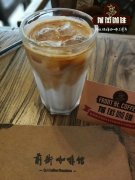What kind of coffee is Ye Jia Xuefei Ding Ding Coffee? a brief introduction to the flavor and taste of Essex Guoding Coffee

Professional coffee knowledge exchange more coffee bean information please follow the coffee workshop (Wechat official account cafe_style)
Introduction of Fruit Ding Coffee washed by Yejia Snow in Qianjie Street
The Godding Cooperative, located in the Waka producing area at the southeast end of Yega Sheffield, was originally part of the Waka Cooperative under the YCFCU of the Yega Sheffield Alliance.
But later, with the pursuit of traceability of raw coffee beans, independent "single producing areas" were excavated by coffee hunters all over the world, so in 2012, Guoding Ding, which has about 300 farmers, was independently established.
Guodingding Village was the first independent village area, and many small farmers were also members of the Waka Cooperative, so the technology of producing coffee was not to mention.
Washing treatment
First, the raw beans were transported to the wet treatment plant, the peel / pulp of the picked berries were removed by a planer, and then placed in the fermentation tank for 1-3 days until the pectin layer decomposed (depending on the local temperature and humidity). Then, the shelled beans will be scrubbed through the washing channel for 30-60 minutes, and the beans with low specific gravity and poor quality can be removed through the channel design combined with water flushing.
After washing, the high quality shell beans are placed in an African scaffolding to dry for about 14 days. after drying, the shell beans are stored in the warehouse of the treatment plant, and then transported to the dry treatment plant to remove the shell before export. and through a series of complicated screening processes, such as foreign body removal, silver skin polishing, gravity screening and so on, finally bagged and exported.
Extraction method-first inject 30g of water and steam for 30 seconds; at the end of steaming, the small flow is poured into 225g; when the extraction time is 2 minutes, remove the filter cup.
This extreme extraction method, the extracted coffee liquid, will highlight the acidity of its bright citrus fruit, but the flavor is also more prominent. The front part is strawberry and sweet orange flavor, with citrus clear rising acidity; the middle section is floral flavor and sugar-like sweetness; the end is round and smooth, with a brief tea taste.
END
Important Notice :
前街咖啡 FrontStreet Coffee has moved to new addredd:
FrontStreet Coffee Address: 315,Donghua East Road,GuangZhou
Tel:020 38364473
- Prev

The grade of Kenyan beans several varieties of coffee in Kenya
Professional coffee knowledge exchange more information on coffee beans Please follow the coffee workshop (Wechat official account cafe_style) even before the end of the colonial era (actually since 1934), the Kenyan coffee industry was based on the government's weekly public auction system. This transparent system is based on Kenya's Coffee Act of 1933, which controls the sale of coffee
- Next

Introduction to the characteristics of sun-dried Yega Chuefei Fruit Ding Coffee beans Flavor description of Yega Xuefei hand flushing method
Professional coffee knowledge exchange more coffee bean information please follow the coffee workshop (Wechat official account cafe_style) in front of the street Yega Xuefei Guoding Village BankoGotitii became independent from the large Waka cooperative in 2012, many self-employed small farmers are also
Related
- Beginners will see the "Coffee pull flower" guide!
- What is the difference between ice blog purified milk and ordinary milk coffee?
- Why is the Philippines the largest producer of crops in Liberia?
- For coffee extraction, should the fine powder be retained?
- How does extracted espresso fill pressed powder? How much strength does it take to press the powder?
- How to make jasmine cold extract coffee? Is the jasmine + latte good?
- Will this little toy really make the coffee taste better? How does Lily Drip affect coffee extraction?
- Will the action of slapping the filter cup also affect coffee extraction?
- What's the difference between powder-to-water ratio and powder-to-liquid ratio?
- What is the Ethiopian local species? What does it have to do with Heirloom native species?

